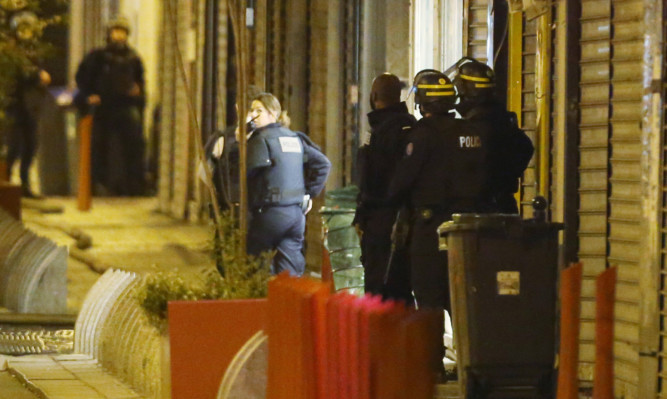The hunt for the suspected mastermind of the Paris attacks took a dramatic twist when he was traced to a bolthole in the French capital – triggering a deadly police raid.
A woman who detonated a suicide belt was one of two suspects to die as heavily armed units stormed the apartment, sparking a shoot-out in the early hours of the morning.
Belgian jihadist Abdelhamid Abaaoud – named by French officials as the man behind the massacre – was initially thought to be in Syria but reports indicated that he was the focus of the operation in the suburb of Saint-Denis in the north of the city.
Visiting the scene, prosecutor Francois Molins said intelligence from telephone surveillance gathered in the wake of the atrocity indicated Abaaoud could be holed up in a building in the area.
He said the identities of those inside the flat at the time of the raid are still being checked.
Swarms of Swat police supported by military units surrounded the building in Rue du Cornillon, a historic street in a culturally diverse area less than 1.2 miles from the Stade de France, where terrorists struck on Friday in the first of a series of attacks that left 129 people dead.
After a siege lasting more than seven hours, in which repeated gunfire and explosions could be heard, a government spokesman said the operation was over.
Five officers suffered minor injures and a police dog was killed, while seven people were arrested.
Stunned residents told how they were ordered to flee the property as officers moved in.
“The police arrived and they said, ‘Get out quick! This building is going to blow up’,” one man said.
The disclosure that Abaaoud is believed to be in Paris poses new questions about how the attackers, a number of whom were on the radar of authorities already, were able to avoid detection.
The 27-year-old has previously boasted of how he evaded police attempts to foil his terror plans before giving an interview to the English-language Islamic State magazine Dabiq, which suggested he was in Syria. His whereabouts since that interview in February had remained unknown.
Belgian authorities had suspected Abaaoud of being the head of a terror cell which was smashed in January in the wake of the attack on French satirical magazine Charlie Hebdo.
Authorities are also searching for two more extremists suspected of taking part in Friday’s attacks.
News of a second unidentified terrorist thought to be directly involved in the Paris atrocity emerged after CCTV indicated there were three extremists involved in the attack on bars in the city.
It would take the total number of attackers to nine, with seven dead and the eighth surviving suspect, Salah Abdeslam, the subject of an international manhunt.
Reports emerged on Wednesday that he was on an EU-wide police list when he was stopped in September in Austria, where officials passed details to Belgian police.
Security services in France were already under pressure after missing an opportunity to detain the 26-year-old, whose brother Brahim has been named as one of the suicide attackers in last week’s outrage.
It was also confirmed on Wednesday that all 129 people killed in the massacres have been identified.
Islamic State – also known as Isil, Isis and Daish – has claimed responsibility for the strike.
